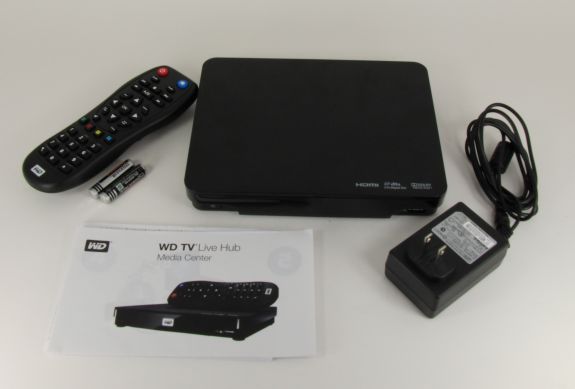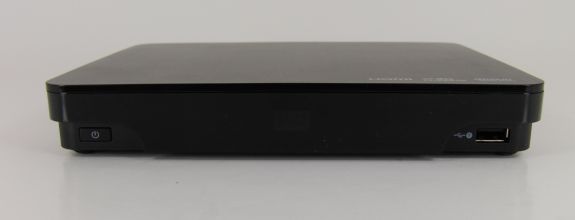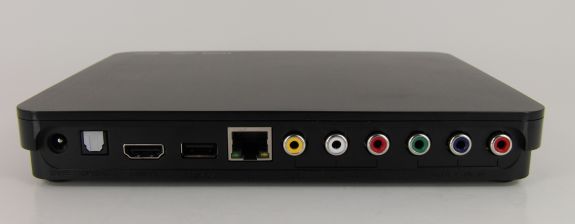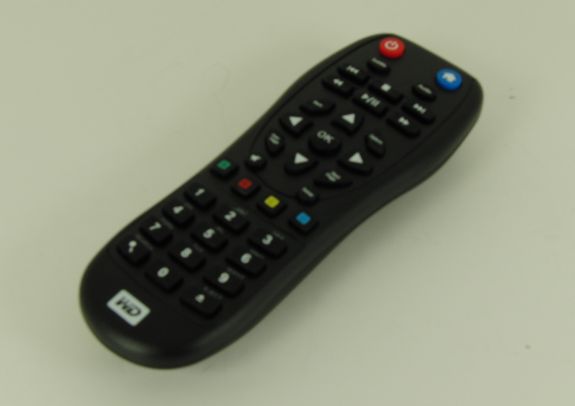Western Digital WDTV Live Hub Review
by Ganesh T S on October 26, 2010 7:38 AM EST- Posted in
- Home Theater
- Media Streamer
- Gadgets
The last few products from Western Digital that I have unboxed have eschewed any unnecessary cables or connectors which usually end up in the unused pile. The WDTV Live Hub was no different. Opening up the package revealed the following contents:
- Short and concise setup guide with pictorial guidance
- Warranty and tech support information booklet
- The main Live Hub unit
- 24W power adapter
- Remote control with 2 batteries
The main unit was surprisingly easy and lightweight to handle. With a diagonal measurement of around 9.5" and a weight of less than 600g, carrying it around was as easy as handling a tablet. Compared to the earlier WDTV models, the height (or depth, depending upon orientation) has been reduced. The new industrial design blends the unit into any home theater setting. One of the main complaints about earlier WDTV units was the lack of an explicit power button on the unit. The Live Hub take care of this, and we now have a recessed rectangular power button in the lower left corner of the front panel. The Live Hub has 2 USB 2.0 ports, and one of them is made available at the lower right corner of the front panel. In the middle is the WD logo lit up from behind by a powerful white LED indicator. By default, this indicator blinks when the internal hard disk is accessed through the network. At other times (when the unit is powered on), this indicator remains lit. Fortunately, the LED can be completely disabled from one of the internal menus.
The rest of the connectivity options are at the rear end of the unit. From the left, we have the power adapter input, optical SPDIF out, HDMI 1.4 output, USB 2.0 port, GbE connector, composite A/V out and component video out.
The remote is a welcome departure from what was used for the earlier versions of the WDTV. With a numeric / text entry keypad akin to the one found on mobile phones, it becomes easier to enter search queries on YouTube / passwords etc. The build quality of the remote is also much better. The plastic at the back of the remote is gone, and overall, it feels much better to hold and operate.
Let us wrap up this section with a table summarizing the A/V and data connectivity options of the WDTV Live Hub.
| Western Digital WDTV Live Hub | ||||
| Feature | WD Config | |||
| HDMI | Yes (v1.4) | |||
| Component | Yes | |||
| Composite | Yes | |||
| VGA | No | |||
| SPDIF | Yes (Optical) | |||
| Stereo | Yes | |||
| Optical Disk Drive | No | |||
| USB | Yes (2 x 2.0) | |||
| eSATA | No | |||
| LAN | Yes (1000 Mbps - GbE) | |||
| Internal HDD | Yes (1 TB) | |||
| WiFi | Supported (Not Included) | |||
| Card Reader | No | |||
In usual reviews, the teardown section would be up next. However, I am going to save that for the last, so as to take readers through the same path of discovery that I went through in the process of evaluating the unit. The next section will deal with the UI of the WDTV Live Hub.














53 Comments
View All Comments
ganeshts - Tuesday, October 26, 2010 - link
I know these aren't in the piece yet. I will try to get those figures in as soon as possible.casteve - Wednesday, October 27, 2010 - link
Ganesh, when you do have a chance to add the power and noise levels...be sure to include power used when off/sleeping/idle. Thanks!ganeshts - Tuesday, November 16, 2010 - link
Sorry for the delay, but the power consumption numbers are as below:1. Power off, adapter connected to the mains (WDTVLiveHub visible on the network) : 7.7W
2. Power off, transferring files to WDTVLiveHub drive over the network: 9.4W
3. Power on, running 1080p video / playing Netflix: 10.7W
4. Power on, running 1080p video, transferring file to internal drive at the same time: 11.3W
dman - Tuesday, October 26, 2010 - link
I'd be interested if it had recording capabilities at this price point. Well, I'm sure a lot of people would be... I just say it because I really don't need the built in HDD on this device since it's not recording anything.It's nice that they've updated the interface, something the previous generation of WD devices have been asking for, however, with Google and Apple getting serious in this space I think WD has been moving a little to slowly here.
Lastly, did they finally include a 30s skip function or is it still just FF/RR while watching shows and the huge 10 or 20 minute (I think) skip?
ganeshts - Wednesday, October 27, 2010 - link
The LiveHub has the ability to navigate to any time instant in the video file. There is an option for a x16 forward / rewind too. No explicit 30s skip as far as I can seeblckgrffn - Tuesday, October 26, 2010 - link
Really? That's getting up into well-connected blu-ray player pricing - not to mention the nettops you can put together for nearly that much...dandar - Tuesday, October 26, 2010 - link
I have an Iomega Home Media NAS. It has gigabit port and it's also limited to an average of 10.6 MB/s. I was getting slightly above 8 MB/s on 100 megabit router so it's a slight upgrade, but a far cry from what I expected (ie 50+ MB/s). They both must have similar bottleneck between the HDD and the network interface.Aikouka - Tuesday, October 26, 2010 - link
If I'm understanding your setup properly, you have a computer and the Iomega Home Media NAS plugged into a 100 Base-T router. Regardless of your NIC's capable speed, you'll never transfer faster than the hardware **between the two points** allows.A 100 Base-T system is theoretically capable of up to 12.5 MB/s (100 / 8).
dandar - Tuesday, October 26, 2010 - link
No, I had it hooked up to 100 megabit router, then I hooked up a gigabit switch in preparation to wiring my house up for nas serving a PS3 and Cinematube. To transfer the files I hooked up my laptop to the switch as well. I haven't tested read speeds yet, but write speeds increased from 8+ MB/s with both my laptop and NAS on my 100 megabit router to 10.6 MB/s with both on the gigabit switch, which incidentally meets what Anandtech got with this box and what other websites got when testing WD Mybook World.Ps. The switch shows both devices connected with gigabit protocols so getting write speeds equivalent to what you could get on a good 100mbps connection is pretty disappointing. Having said that, read speeds should be around 27-30 MBps. Anand or should I say Ganesh should test that and update this review.
Samus - Tuesday, October 26, 2010 - link
That shitty 25mm (sleeve bearing?) fan is going to get really loud, really soon. It's too bad they didn't keep it passively cooled.